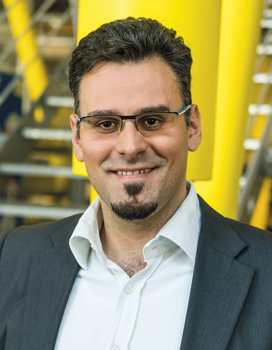Additive Manufacturing for Transmission Components
Even igus, a specialist in the “motion plastics” domain, is exploiting the advantages of 3D printing for the production of drive elements such as bearings, rail guides and sprockets. The company is broadening its offer of materials with a high resistance to wear and corrosion, and with no maintenance and lubrication requirements. We talked about this with Matteo Genovese, New Product Development Manager of the Dry-tech division.
by Silvia Crespi
Additive manufacturing is acquiring an increasing importance in the industrial field. The reason behind its success lies in the possibility of printing special components, from unique specimens to large series, in a simple and economical way. This technology is also gaining ground in the production of mechanical drive train components, and igus is no exception. InMotion met Matteo Genovese, New Product Development Manager of the Dry-tech division, to talk about the steps igus is taking in this direction.
Could you explain why you adopted Additive Manufacturing for some types of components?
igus produces high-performance plastic purposely developed for applications in motion. For the production of these components different processes may be used: injection moulding, milling and even 3D printing.
Additive manufacturing also allows extensive freedom in construction and a production speed such as to allow coping with tighter and toghter schedules. This does not only allow rapid delivery of spare parts, but also the production of special parts, prototypes and small series. This means creating added value for our clients.
Research work for igus is focusing on the development of new materials for additive manufacturing. Could you explain the properties which define these materials and the advantages they offer?
Materials for SLS technology and Tribo-Filaments, like all of our other products in the motion plastics series, withstand wear very well and do not require any maintenance or lubrication. Besides, they are corrosion-proof and particularly light, especially if compared to metal solutions.
Which components produced by igus are most suitable to be manufactured using such a component technology?
In general, 3D printing allows any type of mobile element to be produced. However the technology is particularly suitable within the domain of bearings technology, linear technology and for all sorts of sprockets. There are at any rate a very large amount of application fields which are as yet uncharted, and this, as we work every day side by side with our clients, is increasingly evident.
In which applicative segments are these components mostly used and where will they increasingly be used?
Components for applications in motion thus manufactured find use in a variety of sectors. For instance, pliers and prehensile tools for pick-and-place applications, special bearings for the beginning of series productions or special components subject to wear for the automotive industry, revisions of details which require size changes and spare parts for any type of machine whose parts are hard to find. Even designers repeatedly dealing with prototype creation can derive advantages from them.
How do you envisage evolution in this field; are further investments on your parent company’s part being planned?
In general additive production for igus is still a relatively small sector which however shows rapid growth. Its potential is definitely high. Therefore in this domain we shall increase production capacity further. We would like to ensure that delivery of the single component to the client will be increasingly rapid, allowing frequent technical improvements and cost reduction for its application.
In which other domains is igus concentrating its efforts in terms of Research & Development?
We are carrying out research in all sectors. We continuously machine products in high-performance polymers, new and improved for use in dynamic applications. In this respect considerable steps forward have been made especially in low-cost automation while in the field of energy chains new concepts are constantly being developed.
This is always done with the aim of improving and providing our clients with the possibility of developing, both technically and from a business standpoint.

